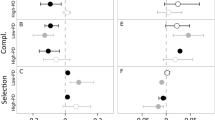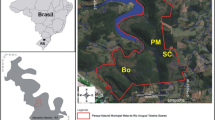Abstract
Background and aims
The study aimed to assess the effects of the potential replacement of dominant native plants by co-occurring exotic invasives on organic matter degradation in a riparian area. The questions were: i) Is there a relationship between the litter breakdown rate and species origin? ii) Is the chemical composition more relevant than species origin? iii) Does species origin influence the associated saprophagous invertebrate community?
Methods
Within the riparian zone of the Garonne River (France), we conducted a litterbag experiment using pairs of native and exotic species selected in the stages of the successional gradient.
Results
Native and exotic species did not differ in their primary chemical composition and breakdown rate. Litter breakdown rates were primarily driven by the C:N ratio with no influence of species origin. The abundance and diversity of saprophagous invertebrates of exotic and native species did not differ, but the composition did. Only one plant litter was completely degraded much earlier than expected (next litterfall) while remnant litter were still present at this time for the other species.
Conclusions
The replacement of a dominant native by an exotic invasive plant species does not generally result in noticeable changes in the litter breakdown rate, which mainly depends on litter composition. Litter from quickly degrading exotic species may cause a resource discontinuity in invaded areas stabilized by river regulation.




Similar content being viewed by others
References
Aerts R (1997) Climate, leaf litter chemistry and leaf litter decomposition in terrestrial ecosystems: a triangular relationship. Oikos 79:439–449
Aerts R, De Caluwe H, Beltman B (2003) Plant community mediated vs. nutritional controls on litter decomposition rates in grasslands. Ecology 84:1398–3208
Aguiar FC, Ferreira MT, Albuquerque A, Bernez I (2005) Invasibility Patterns of Knotgrass (Paspalum distichum) in Portuguese Riparian Habitats. Weed Technology, 19(3):509–516
Alpert P (2006) The advantages and disadvantages of being introduced. Biol Invasions 8:1523–1534
Ashton IW, Hyatt LA, Howe KM, Gurevitch J, Lerdau MT (2005) Invasive species accelerate decomposition and litter nitrogen loss in a mixed deciduous forest. Ecol Appl 15:1263–1272
Ayres E, Dromph KM, Bardgett RD (2006) Do plant species encourage soil biota that specialise in the rapid decomposition of their litter? Soil Biol Biochem 38:183–186
Bailey JK, Schweitzer JA, Whitham TG (2001) Salt cedar negatively affects biodiversity of aquatic macroinvertebrates. Wetlands 21:442–447
Baldy V, Gobert V, Guerold F, Chauvet E, Lambrigot D, Charcosset JY (2007) Leaf litter breakdown budgets in streams of various trophic status: effects of dissolved inorganic nutrients on microorganisms and invertebrates. Freshw Biol 52:1322–1335
Beerling DJ, Perrins JM (1993) Impatiens glandulifera royle (impatien roylei walp.). J Ecol 81:367–382
Beerling DJ, Bailey JP, Conolly AP (1994) Fallopia Japonica (Houtt.) Ronse Decraene. J Ecol 82:959–979
Bernez I, Aguiar F, Violle C, Ferreira T (2006) Invasive river plants from Portugese floodplains: what can species attributes tell us? Hydrobiologia 570:3–9
Bottollier-Curtet M, Charcosset JY, Planty-Tabacchi AM, Tabacchi E (2011) Degradation of native and exotic riparian plant leaf litter in a floodplain pond. Freshw Biol 14:1445–1458
Braatne JH, Mažeika S, Sullivan P, Chamberlain E (2007) Leaf decomposition and stream macroinvertebrate colonisation of japanese knotweed, an invasive plant species. Int Rev Hydrobiol 92:656–665
Buranov AU, Mazza G (2008) Lignin in straw of herbaceous crops. Ind Crop Prod 28:237–259
Carpita NC (1996) Structure and biogenesis of the cell wall of grasses. Annu Rev Plant Physiol Plant Mol Biol 47:445–476
Cebrian J, Lartigue J (2004) Patterns of herbivory and decomposition in aquatic and terrestrial ecosystems. Ecol Monogr 74:237–259
Chapelle JP (1974) 2-Methoxy-1,4-naphthoquinone in Impatiens glandulifera and related species. Phytochemistry 13:662
Child LE, Wade M (eds) (2000) The Japanese knotweed manual: the management and control of an invasive alien weed. Packard Publishing, Chichester, 123 pp
Coleman DC, DA Crossley J, Hendrix PF (2004) Fundamentals of soil ecology. Elsevier, Burlington
Cornelissen JHC (1996) An experimental comparison of leaf decomposition rates in a wide range of temperate plant species and types. J Ecol 84:573–582
Cummins KW, Klug KW (1979) Feeding ecology of stream invertebrates. Annu Rev Ecol Syst 10:147–172
DAISIE 2010. European Invasive Alien Species Gateway. Available at http://www.europe-aliens.org. Accessed 6 November 2013
Ehrenfeld JG (2003) Effects of exotic plant invasions on soil nutrient cycling processes. Ecosystems 6:503–523
Ehrenfeld JG (2006) A potential source of information for screening and monitoring the impact of exotic plants on ecosystems. Biol Invasions 8:1511–1521
Ehrenfeld JG (2010) Ecosystem consequences of biological invasions. Annu Rev Ecol Syst 41:59–80
Emery SL, Perry JL (1996) Decomposition rates and phosphorus concentrations of purple loosestrife (Lythrum salicaria) and cattail (Typha spp.) in fourteen Minnesota wetlands. Hydrobiologia 323:129–138
Flindt MR, Lillebø AI (2005) Determination of total nitrogen and phosphorus in leaf litter. In: Graça MAS, Bärlocher F, Gessner MO (eds) Methods to study litter decomposition: a practical guide. Springer, Berlin, pp 45–50
Gessner MO, Chauvet E (1994) Importance of stream microfungi in controlling breakdown rates of leaf litter. Ecology 75:1807–1817
Godoy O, Castro-Díez P, Van Logtestijn RSP, Cornelissen JHC, Valladares F (2009) Leaf litter traits of invasive species slow down decomposition compared to Spanish natives: a broad phylogenetic comparison. Oecologia 162:781–790
Gutiérrez-López M, Ranera E, Novo M, Fernández R, Trigo D (2014) Does the invasion of the exotic tree Ailanthus altissima affect the soil arthropod community? The case of a riparian forest of the Henares River (Madrid). Eur J Soil Biol 62:39–48
Hallac BB, Ray M, Murphy RJ, Ragauskas AJ (2010) Correlation between anatomical characteristics of ethanol organosolv pretreated Buddleja davidii and its enzymatic conversion to glucose. Biotechnol Bioeng 107:795–801
Harner MJ, Crenshaw CL, Abelho M, Stursova M, Shah JJF, Sinsabaugh RL (2009) Decomposition of leaf litter from a native tree and an actinorhizal invasive across riparian habitats. Ecol Appl 19:1135–1146
Hejda M, Pysek P (2006) What is the impact of Impatiens glandulifera on species diversity in invaded vegetation? Biol Conserv 132:143–152
Hladyz S, Gessner MO, Giller PS, Pozo J, Woodward G (2009) Resource quality and stoichiometric constraints on stream ecosystem functioning. Freshw Biol 54:957–970
Hood WG, Naiman RJ (2000) Vulnerability of riparian zones to invasion by exotic vascular plants. Plant Ecol 148:105–114
Irmler U (2014) Changes in the fauna and its contribution to mass loss and N release during leaf litter decomposition in two deciduous forests. Pedobiologia 44(2):105–118
Kappes H, Lay R, Topp W (2007) Changes in different trophic levels of litter-dwelling macrofauna associated with giant knotweed invasion. Ecosystems 10:734–744
Keiser AD, Keiser DA, Strickland MS, Bradford MA (2014). Disentangling the mechanisms underlying finctional differences among decomposer communities. Journal of Ecology, doi: 10.1111/1365-2745.1222
Kendle AD, Rose JE (2000) The Aliens have landed! What are the justifications for ‘native only’ policies in landscape plantings? Landsc Urban Plan 47:19–31
Langhans SD (2006) Riverine floodplain heterogeneity as a controller of organic matter dynamics and terrestrial invertebrate distribution. PhD Thesis, Swiss federal institute of technology, Zurich.
Lecerf A, Patfield D, Boiche A, Riipinen MP, Chauvet E, Dobson M (2007) Stream ecosystems respond to riparian invasion by Japanese knotweed (Fallopia japonica). Can J Fish Aquat Sci 64:1273–1283
Lobstein A, Brenne X, Feist E, Metz N, Weniger B, Anton R (2001) Quantitative determination of naphthoquinones of Impatiens species. Phytochem Anal 12:202–205
Melillo JM, Aber JD, Muratore JF (1982) Nitrogen and lignin control of hardwood leaf litter decomposition dynamics. Ecology 63:621–626
Miller A (1984) The distribution and ecology of Buddleja davidii Franch in Britain, with particular reference to conditions supporting germination and the establishment of seedlings. Ph.D. Dissertation, CNAA, Oxford Polytechnic
Naiman RJ, Décamps H (1997) The ecology of interfaces: Riparian zones. Annu Rev Ecol Syst 28:621–658
Olson JS (1963) Energy storage and the balance of producers and decomposers in ecological systems. Ecology 44:322–331
Ostrofsky ML (1997) Relationship between chemical characteristics of autumn-shed leaves and aquatic processing rates. J N Am Benthol Soc 16:750–759
Pan XP, Gilke N, Kadla J, Pye K, Saka S, Gregg D, Ehara KX, Lam D, Saddler J (2006) Bioconversion of hybrid poplar to ethanol and co-products using an organosolv fractionation process: optimization of process yields. Biotechnol Bioeng 94:851–861
Pereira AP, Graça MAS, Molles M (1998) Leaf litter decomposition in relation to litter physico-chemical properties, fungal biomass, arthropod colonization, and geographical origin of plant species. Pedobiologia 42:316–327
Petersen H, Luxton M (1982) A comparative analysis of soil fauna populations and their role in decomposition processes. Oikos 39:288–388
Planty-Tabacchi AM, Tabacchi E, Naiman RJ, Deferrari C, Décamps H (1996) Invasibility of species-rich communities in riparian zones. Conserv Biol 10:598–607
Richardson DM, Holmes PM, Esler KJ, Galatowitsch SM, Stromberg JC, Kirkman SP, Pysek P, Hobbs RJ (2007) Riparian vegetation: degradation, alien plant invasions, and restoration prospects. Divers Distrib 13:126–139
Rusterholz H.P., Salamon J. P., Rucklia R., Baura B. (2014). Effects of the annual invasive plant Impatiens glandulifera on the Collembola and Acari communities in a deciduous forest. Pedobiologia, in press.
Schneider K, Migge S, Norton RA, Scheu S, Langei R, Reineking A, Maraun M (2004) Trophic niche differentiation in soil microarthropods (Oribatida, Acari): evidence from stable isotope ratios (15N/14N). Soil Biol Biochem 36(11):17769–1774
Schnitzler A, Hale BW, Aslum EM (2007) Examining native and exotic species diversity in European riparian forests. Biol Conserv 138:146–156
Smith MD, Knapp AK (2001) Physiological and morphological traits of exotic, invasive exotic, and native plant species in tallgrass prairie. Int J Plant Sci 162:785–792
Strickland MS, Osburn E, Lauber C, Fierer N, Bradford MA (2009) Litter quality is in the eye of the beholder: initial decomposition rates as a function of inoculum characteristics. Funct Ecol 23:627–636
Tabacchi E, Planty-Tabacchi AM (2003) Recent changes in riparian vegetation: possible consequences on dead wood processing along rivers. River Res Appl 19:251–263
Tabacchi E, Planty-Tabacchi AM (2005) Exotic and native plant community distributions within complex riparian landscapes: A positive correlation. Ecoscience 12:412–423
Thompson K (1994) Predicting the fate of temperate species in response to human disturbance and global change. In: Boyle TJB, Boyle CEB (eds) NATO advanced research workshop on biodiversity, temperate ecosystems and global change. Springer, Berlin, pp 61–76
Tickner DP, Angold PG, Gurnell AM, Mountford JO, Sparks T (2001) (2001) Plant invasions: Species Ecology and Ecosystem Management. In: Brundu G, Brock J, Camarda I, Child L, Wade M (eds) Hydrology as an influence on invasion: experimental invezstigations on the copmpetition between the alien Impatiens glandulifera and the native Urtica dioica in the UK. Backhuys Publ, The Netherlands, pp 158–168
Van Soest PJ (1963) Use of detergents in the analysis of fibrous feeds II. A rapid method for the determination of fiber and lignin. J Assoc Off Anal Chem 46:829–835
Vitousek PM, D’antonio CM, Loope LL, Westbrooks R (1996) Biological invasions as global environmental change. Am Sci 84:468–478
Webster JR, Benfield EF (1986) Vascular plant breakdown in freshwater ecosystems. Annu Rev Ecol Syst 17:367–394
Wieder RK, Lang GE (1982) A critique of the analytical methods used in examining decomposition data obtained from litter bags. Ecology 63:1636–1642
Xiong S, Nilsson C (1997) Dynamics of leaf litter accumulation and its effects on riparian vegetation: a review. Bot Rev 63:240–264
Xiong S, Nilsson C (1999) The effects of plant litter on vegetation: a meta-analysis. J Ecol 87:984–994
Acknowledgments
We are gratefull to Celinde Ricoveri, Thomas Lheureux, Mickael Taland, Didier Lambrigot, Sylvain Lamothe, Lydie Roques, Raphaëlle Leclerc and Bruno Buatois for laboratory assistance. We also thank Jean Moro to make the field access easier. We thank the two anonymous reviewers for helpful comments. M. Bottollier-Curtet benefited from a French MESR fellowship.
Author information
Authors and Affiliations
Corresponding author
Additional information
Responsible Editor: Alfonso Escudero .
Electronic supplementary material
Below is the link to the electronic supplementary material.
ESM 1
(DOC 983 kb)
Rights and permissions
About this article
Cite this article
Bottollier-Curtet, M., Charcosset, JY., Planty-Tabacchi, AM. et al. Chemical composition rather than plant geographic origin drives the breakdown of riparian plant litter with changes in associated invertebrate diversity. Plant Soil 390, 265–278 (2015). https://doi.org/10.1007/s11104-015-2394-8
Received:
Accepted:
Published:
Issue Date:
DOI: https://doi.org/10.1007/s11104-015-2394-8




